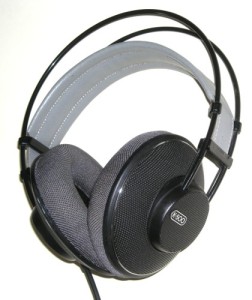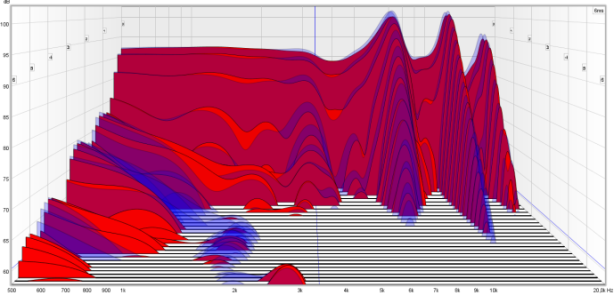K500
back to AKG
back to measurements
home
published: Jul-13-2014, updated Feb-15-2021
NO SMOOTHING is applied to the shown plots. Most measurement sites have some smoothing applied which ‘irons flat’ sharp peaks and ‘wiggles’. I do not use smoothing because some info about sound quality is lost when plots are smoothed.
Aside from a small correction of the microphone itself also some correction in the lowest frequencies is applied to the plots to compensate for the perceived loss of bass when using headphones. This is described HERE in more detail.
A ‘horizontal‘ frequency response curve on the shown frequency response plots on this website thus indicates a perceived ‘flat’ tonal signature.
ALL measurements are made with a good SEAL on a flatbed measurement rig.
The shape of your head, bone structure, pad size, pad ‘softness, (compliance), hair or no hair and or wearing glasses may (drastically) change the frequency response of some headphones, so… your personal experience may differ substantially from these plots.
Frequency response (tonal balance) is the most sound-determining aspect of headphones. A horizontal line shows audible neutral response in the plots on this website. Deviations in different severities at different frequency bands have an effect on the sound character.
The bigger the deviation the stronger the effect.
Below an aid to help determining the sound character of headphones with relation to the frequency response.

AKG K500
The K500 was the more expensive bigger brother of the K400 with more luxurious looks and headband as well as a different colour scheme.
The elastic bands that pull down the headband do wear after time and need to be replaced sooner or later.
It has the familiar AKG look and is simple and elegant. The pads are cloth instead of pleather or velour and very comfortable for longer listening sessions.
It is an open headphone design and sounds from the outside enter almost unattenuated. People around you can hear what you are playing.
specifications:
Type: Over-ear, Open
Usage: Home, Studio
Isolation: poor, as it is an open design
Driver type: dynamic
Pads: replaceable, cloth
Inner pad dimensions: diameter: 60mm, 24mm
Collapsible: no
Headphone connector: fixed
Cable entry: left sided.
Cable: 3m with 3.5mm TRS plug and screw-on 6.3mm adapter.
Driver size: ø 40mm
Nom. power rating: 200mW
Max. voltage: 4.9V
Max. current: 41mA
Max. S.P.L.: 116dB
Impedance: 120Ω
Efficiency: 94dB @ 1mW
Sensitivity: 103dB @ 1V
Weight: 230g. (without cable)
Colour: black with grey accents
Clamping force: medium/low
Accessories: screw-on 6.3mm adapter
sound description
The K500 sounds very realistic and open but severely lacks bass and subbass. Treble can be sharp but also sounds very ‘detailed’ because of this.
Bass extension cannot be improved much. The K500 doesn’t react well to a bass boost via EQ.
measurements
It sounds quite similar to the K400 but the treble is somewhat more refined sounding. Still not as refined as the better headphones though.
Bass and mids sound identical to the K400 and with the same shortcoming… the lack of body and bass extension. A very ‘open’ sound. left, right
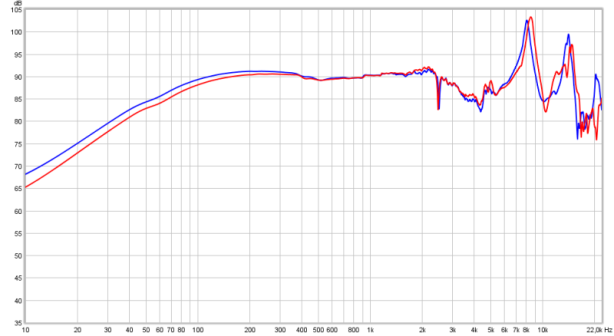
Below the K500 vs the K400

The only difference seems to be the pads changing the driver-ear distance and thus the resonances shift a bit lower. It should be noted that the resonance peaks in reality will be lower and wider because of the pinna, which is lacking in these measurements.
The CSD shows a shorter lived ringing around 8kHz but also has a substantial ringing around 2.5kHz. Fortunately our ear canals also ring (resonate) around that frequency and thus our brains don’t really mind this as much as the ringing at higher frequencies. For the K500, even though it is slightly better sounding, still means the treble isn’t as smooth/refined as some of the better headphones can produce. The K500 also has a bright ‘edge’ resulting in a slight feeling of ‘extra detail’. left, right
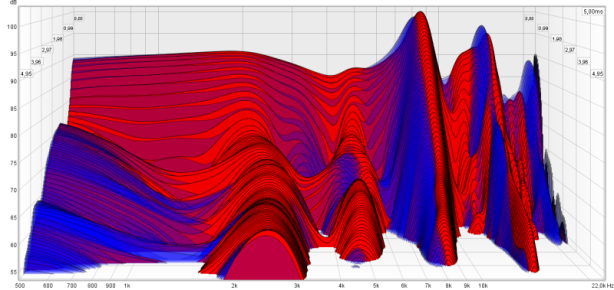
The owner also had K601 pads which can easily replace the original pads. The K601 pads are velours type and feel a bit stiffer to the touch but still very comfortable. The picture below shows what a K601 padded K500 looks like. Together with the grey leather headband looks as if it could be an original combination.
 The question is what it does to the sound as replacing pads often alters the sound and can do so in various ways. Fortunately changing the pads only has positive results. The treble at 8kHz is lowered in amplitude and frequency. This may be because of a different amount of air in the ‘ear chamber’, or because of a somewhat different driver-to-ear distance or absorption/reflection of sound waves by the pads… who knows. Also you gain 3dB of gain below 50Hz. As most bass instruments do not have fundamentals much lower than that the K500 with K601 pads sounds somewhat better in the bass area. It still lacks bass extension though and while slightly improving the treble quality (which isn’t bad but below that of better headphones) it still has a somewhat artificial treble. Tonal balance is ‘accurate’ and very realistic.
The question is what it does to the sound as replacing pads often alters the sound and can do so in various ways. Fortunately changing the pads only has positive results. The treble at 8kHz is lowered in amplitude and frequency. This may be because of a different amount of air in the ‘ear chamber’, or because of a somewhat different driver-to-ear distance or absorption/reflection of sound waves by the pads… who knows. Also you gain 3dB of gain below 50Hz. As most bass instruments do not have fundamentals much lower than that the K500 with K601 pads sounds somewhat better in the bass area. It still lacks bass extension though and while slightly improving the treble quality (which isn’t bad but below that of better headphones) it still has a somewhat artificial treble. Tonal balance is ‘accurate’ and very realistic.
Differences between stock K500 pads and the same headphone fitted with K601 pads.
Below the CSD of the left channel with original pads and K601 pads. As can be seen resonances are still there and do not appear to have changed that much except shifted in frequency (the ones above 6kHz). It also shows the K601 pads have somewhat more resonance around 1kHz but don’t find it is audible.
K500 #2
The owner of this headphone had 2 of these K500’s and one would think that they would measure quite similar. This one was already fitted with K601 pads. The frequency plots indeed resemble each other quite closely and with both headphones having similar pads the sound very similar as well. left, right
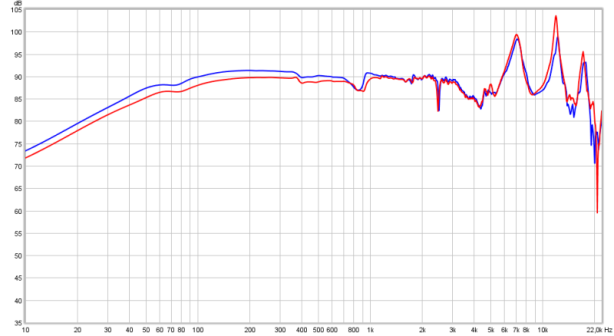
Bass extension differs because of the K601 pads.
Below distortion measurement of the K500 with K601 pads.

Same data below but now in percentage scale.

Note distortion plot is THD only. Distortion is a bit higher than that of the K400. Still not alarmingly high. Increasing the subbass wil dramatically increase distortion in the lows.
The CSD, however, shows a quite different behaviour. No resonances around 1kHz and no resonances around 2.5kHz and a much shorter lived 7kHz resonance. The 13khz resonance is still the same. I would be hard pressed to find audible differences between the 2 different K500’s which, in the end, may be proof of a 2.5kHz resonance to not be so detrimental to sound quality. The K601 pads on this version were already used while the ones used on the other K500 (the one with the 2.5kHz resonance) were new unused ones.
Because this K500 didn’t show the 2.5kHz resonance I figured the K601 pads would be responsible for this improvement in the 2.5kHz area.
Fitting new K601 pads on the other K500 showed it was a difference between drivers after all. left, right
below the spectrum plot of the K500 (the one tested on top of this page)
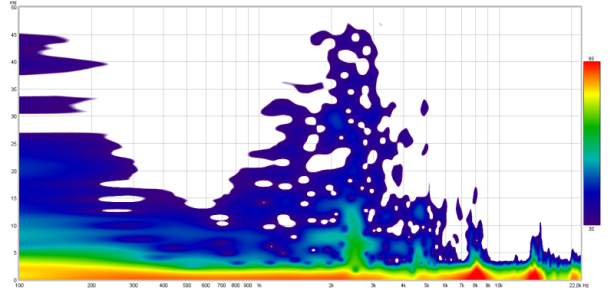
It shows resonances around 2.5kHz and just below 5kHz. The frequencies below 300Hz show no lingering and the driver is well behaved at these frequencies.
Below the step response of the K500 with stock pads. The bass-shy character (horizontal part dropping quickly) is evident. Also there is a lot of poorly damped ringing going on.
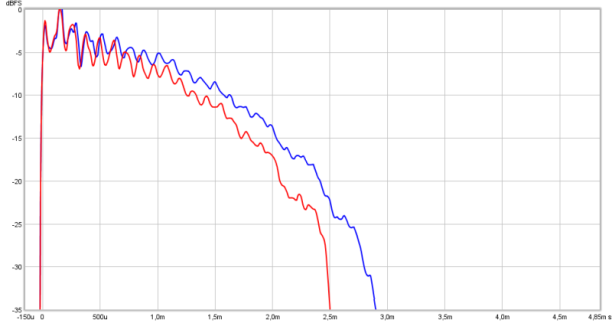
It is somewhat better with the 2nd K500 (with K601 pads). The ringing is somewhat shorter and bass extension is better but still a bit lacking.

conclusion
The positives are a very neutral sound, no muddy-ness with good comfort. Sounds good with Jazz and classical.
Negatives are the lack of body (bass extension) and the slightly ‘artificial’ treble though an improvement over the K400.
The K601 pads bring some improvements which are most noticeable in having slightly more body.
See this in a subtle way as it remains a headphone that still lacks bass extension.
These are old models and can only be found 2nd hand. They are sought after because of their midrange presentation and detail. The fans seem to ignore or not mind the bass roll-off.

